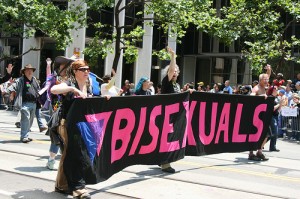Research about male bisexuality has been controversial. Unhealthy attitudes toward male bisexuality have infected science just as they have other parts of culture. A recent study might change this, as discussed by Elaine Hirsch in this week’s guest post.

One of the most controversial studies in human sexuality was presented by psychologists holding PhDs and Master’s Degrees from Chicago and Toronto in 2005. The study concluded that the jury was out on whether male bisexuality is a true phenomenon. Not only was this conclusion a slap in the face to famous psychologists such as Sigmund Freud and Alfred Kinsey, it was the most prominent scientific study to date which purported to disprove the existence of bisexuality in males.
Fast-forward to 2011, when a group of researchers at Northwestern University conducted a similar study finding evidence that male bisexuality does indeed exist. In an article entitled, “No Surprise to Bisexual Men: Report Indicates They Exist,” the research methods of the 2005 and 2011 trials were scrutinized in order to conclude why different groups of psychologists came to different conclusions.
Both trials required participants to watch intimate homosexual videos (it’s hard to discern which actor participants are watching in typical heterosexual pornography) while genital monitors were used to measure their arousal levels. In the prior study psychologists concluded that participants who reported that they were bisexual were only aroused by one gender or the other. The new study, on the other hand, concluded that participants were aroused by both genders.
Differences in recruitment is one factor in differing results. The former study only required participants to verbally state their sexuality in order to be inducted into the study. The latter required participants to have had both physical and romantic contact with at least two people in the past three months in order to qualify. Not only does it mark a more stringent process of weeding out unmeasured variables in the trial, it also brought further scientific legitimacy.

One major problem with both of the studies has been the lack of adequate sample sizes compared to traditional studies. The former study included 59 men (13 bisexuals) while the latter study included 100 men (evenly split). Regardless, a study validating the existence of bisexuality in males in a scientific setting has been seen as a huge step for bisexual males in gaining acceptance in society. According to Lisa Diamond, a psychologist at the University of Utah, she’s “interviewed a lot of individuals about how invalidating it is when their own family members think they’re confused. These converging lines of evidence, using different methods and stimuli, give us the scientific confidence to say this is something real.”
As the article’s title suggested, validating male bisexuality comes as a complete no-brainer to others. Jim Larsen, chairman of the Bisexual Organizing Project, admitted that “it’s great that they’ve come out with affirmation that bisexuality exists. Having said that, they’re providing what we in the community already know. It’s insulting. I think it’s unfortunate that anyone doubts an individual who says, ‘this is what I am and who I am.'”
Despite issues in sample size and human ignorance, this study represents a stark shift in how bisexual males are perceived in today’s society. Biphobia isn’t going away anytime soon, but this study is a big step to bringing scientific legitimacy to a sentiment which bisexual men have felt in their hearts for their entire lives.
Elaine Hirsch is kind of a jack-of-all-interests, from education and history to medicine and videogames. This makes it difficult to choose just one life path, so she is currently working as a writer for various education-related sites and writing about all these things instead.
